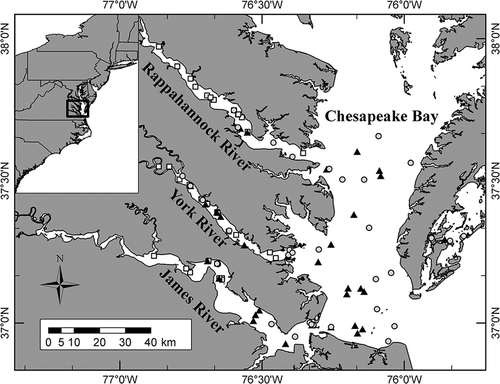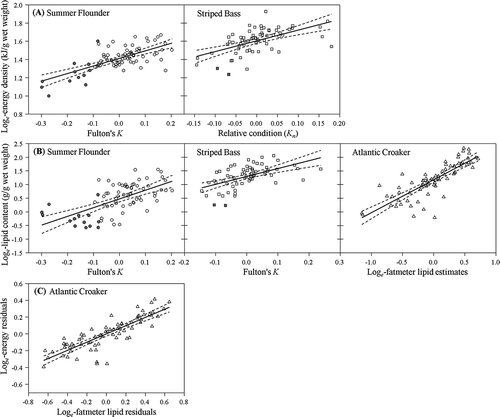Figures & data
FIGURE 1. Spatial extent of sampling in Virginia estuaries for Summer Flounder (circles; n = 73), Striped Bass (squares; n = 66), and Atlantic Croakers (triangle; n = 72) used in comparisons of direct and indirect condition indices.

TABLE 1. Descriptive statistics for direct and indirect condition indices (Fulton’s K = Fulton’s condition factor; Kn = relative condition factor; L–M = length–mass; HSI = hepatosomatic index) measured from the same Summer Flounder (n = 73), Striped Bass (n = 66), and Atlantic Croakers (n = 72). The L–M deviations are the deviations from nonlinear regression models for fish length (mm) and mass (g) given by equations (3)–(5). Due to collinearity among predictors, the means of the raw indirect condition data were subtracted from individual observations of condition to estimate relationships between indirect condition indices and energy density (kJ/g of wet mass) or lipid content (g/g of wet mass).
TABLE 2. Values of r2 between indirect condition indices (Fulton’s K = Fulton’s condition factor; Kn = relative condition factor; L–M = length–mass; HSI = hepatosomatic index) and loge transformed energy density (kJ/g of wet mass) and lipid content (g/g of wet mass) for juvenile Summer Flounder, Striped Bass, and Atlantic Croakers. Relative estimates of lipid content measured with the fatmeter were taken from both sides of each individual (FatmeterMean represents the average) and loge transformed to identify the “best” location for assessing lipid content. An asterisk denotes the fatmeter location used for index comparisons. All values were significant (P < 0.05) unless indicated by footnotes.
TABLE 3. General linear models used to predict energy density (kJ/g of wet mass) and lipid content (g/g of wet mass) with indirect condition indices (Fulton’s K = Fulton’s condition factor; Kn = relative condition factor; L–M = length–mass; HSI = hepatosomatic index) and fish length for Summer Flounder (n = 73), Striped Bass (n = 66), and Atlantic Croakers (n = 72). Predictors were centered about their means (), and Akaike’s information criterion corrected for small sample size (AICc) was used for final model selection (ΔAICc = difference in AICc value between the given model and the best-performing model). Parameter estimates for final models are presented with 95% confidence intervals. The proportion of the total variation in energy density and lipid content explained by the indirect condition indices was determined by using a restricted maximum likelihood (REML)-based r2 estimate ().
FIGURE 2. (A) Linear regressions (solid lines) of energy density and selected indirect condition indices for Summer Flounder and Striped Bass; (B) regressions of lipid content and selected indirect indices for all three species; and (C) partial regression plot used to assess the relationship between relative lipid estimates measured with the fatmeter and energy density for Atlantic Croakers. The indices shown are those selected from the general linear models based on the lowest Akaike’s information criterion corrected for small sample size (; Fulton’s K = Fulton’s condition factor). The solid symbols indicate laboratory-held individuals; the dashed lines denote 95% confidence intervals around the equations used to predict loge transformed energy and lipid content (see ).

